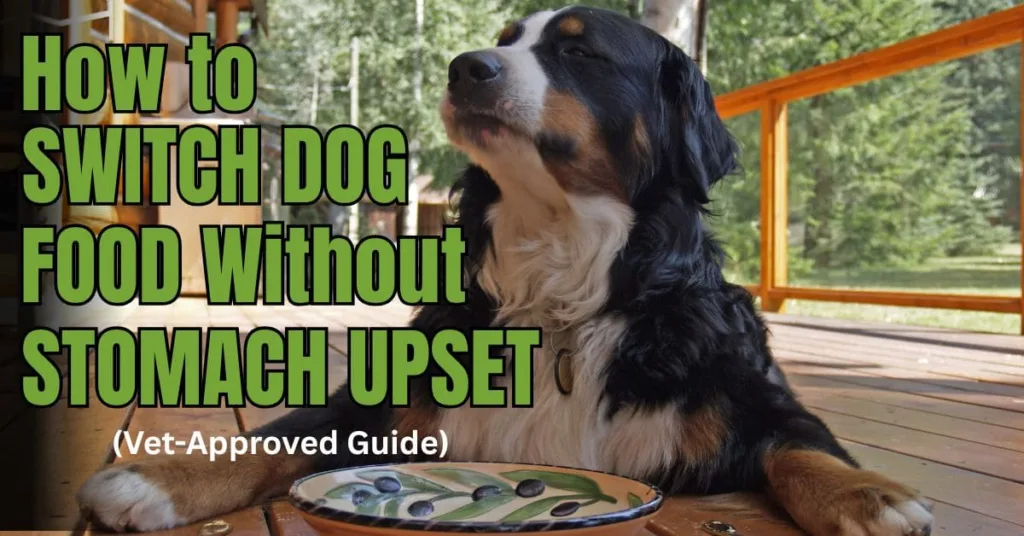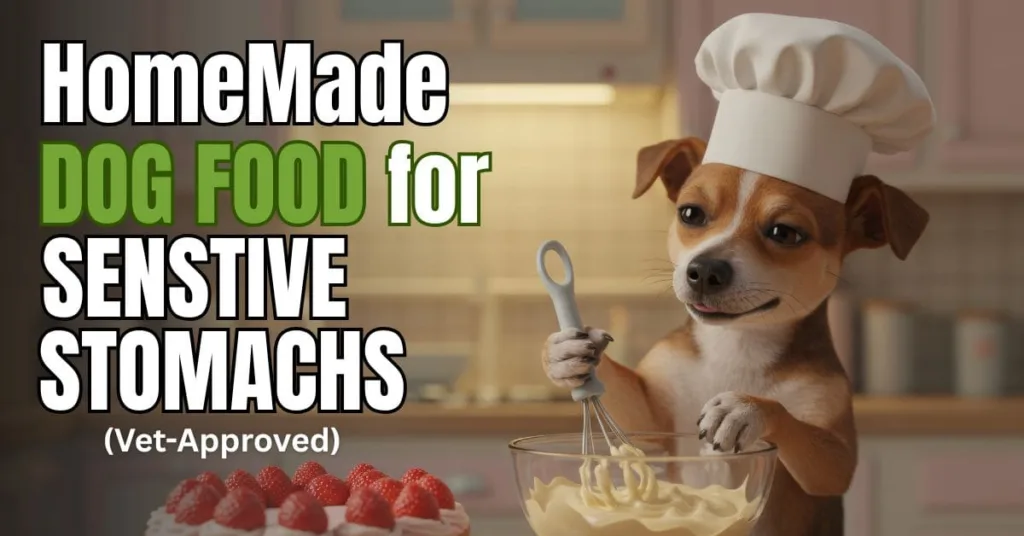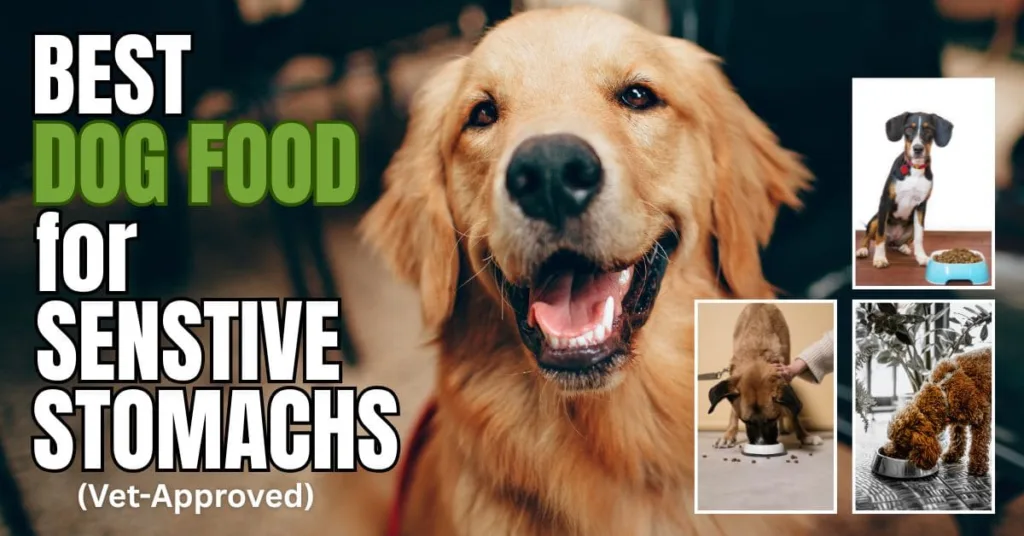Changing your dog’s food might seem easy — but your pup’s sensitive stomach often says otherwise. 🐾 Many pet parents rush the process and end up dealing with vomiting, diarrhea, or loss of appetite. The truth is, a dog’s digestive system needs time to adapt to new ingredients, protein sources, and nutrients. Switching too quickly can upset the natural balance of gut bacteria, leading to unnecessary tummy troubles.
That’s why learning how to switch dog food without stomach upset is so important. A slow, step-by-step transition helps your dog’s digestive system adjust smoothly while keeping their appetite and energy levels stable.
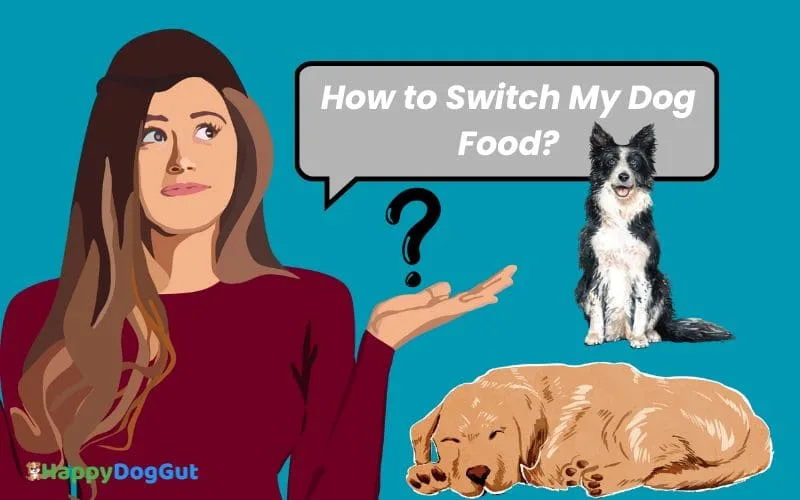
In this vet-approved guide, you’ll discover the safest way to transition your dog’s food — whether you’re moving from puppy to adult food, changing brands, or introducing a new formula. We’ll also share an easy 11-day transition schedule, expert tips for sensitive stomachs, and common mistakes every dog owner should avoid.
👉 If your pup is already dealing with nausea or loose stools, don’t worry — check out our detailed guide on How to Calm a Dog’s Upset Stomach Naturally for quick, vet-backed relief tips.
Why Gradual Food Transition Matters
When you suddenly switch your dog’s food, you’re not just changing what’s in their bowl — you’re shocking their gut. The gut microbiome, a delicate balance of beneficial bacteria inside your dog’s stomach, needs time to adjust to new proteins, fats, and carbohydrates. If the change happens too quickly, these microbes can’t adapt fast enough, leading to digestive upset — including gas, bloating, loose stools, and even vomiting.
A gradual food transition allows your dog’s digestive enzymes and gut bacteria to slowly adapt to the new formula. This smooth adjustment helps prevent stomach upset and keeps your pup’s appetite stable. Most veterinarians recommend transitioning over 8–11 days, increasing the new food portion a little each day.
Here’s why patience pays off when you switch dog food without stomach upset:
⚠️ Sudden changes can cause:
- Diarrhea or frequent loose stools 💩
- Excessive gas or bloating 💨
- Loss of appetite or refusal to eat 🍲
- Lethargy or mild nausea 🤢
Taking it slow doesn’t just protect your dog’s tummy — it also helps their immune system and gut health stay strong during the change.
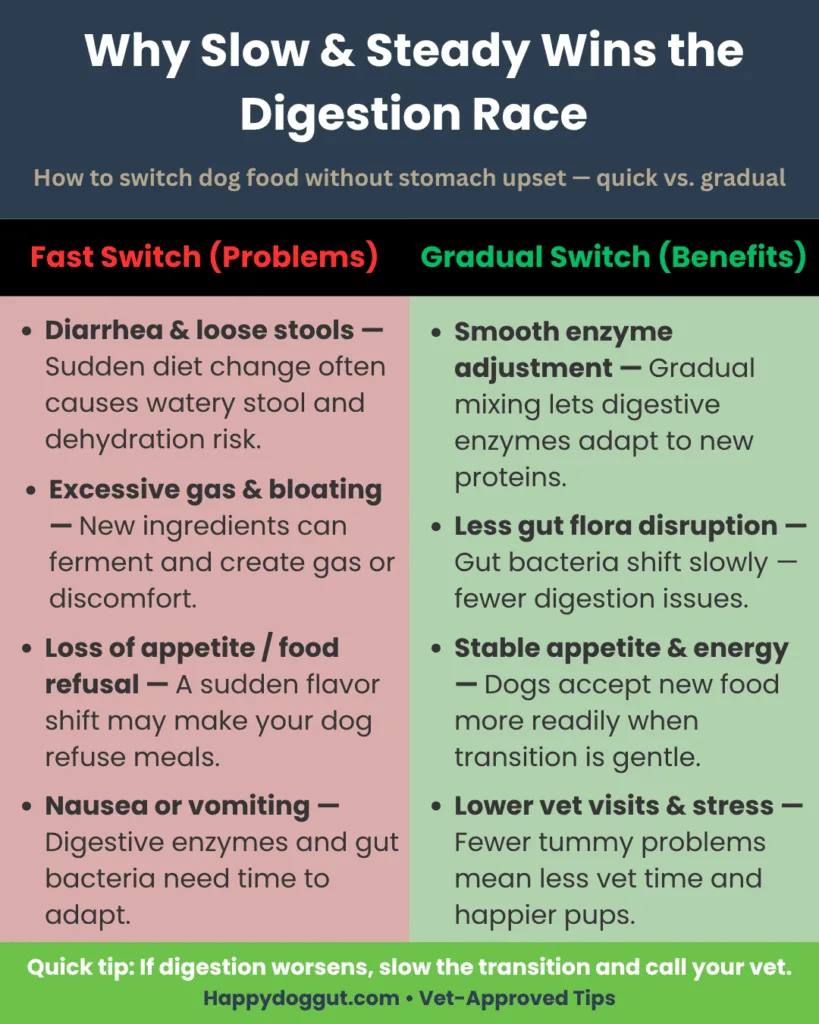
👉 Pro tip: If your dog already has a sensitive stomach, you might also like our guide on Best Dog Foods for Sensitive Stomachs (2025 Vet-Approved List). It pairs perfectly with this food transition plan.
How to Switch Dog Food Without Upset Stomach
Here’s a vet-approved step-by-step transition schedule to make the switch smooth and safe 👇
| Days | Old Food | New Food |
|---|---|---|
| Day 1–3 | 75% | 25% |
| Day 4–6 | 50% | 50% |
| Day 7–10 | 25% | 75% |
| Day 11+ | 0% | 100% |
During this transition:
- Observe stool consistency. If it becomes loose, slow the transition by repeating the same ratio for another 2 days.
- Mix foods well to prevent your dog from picking out the old food.
- Add warm water or low-sodium bone broth if your dog resists the new food.
💡 Pro Tip: Always change to a similar protein (e.g., chicken to chicken) before switching to a completely different type (like chicken to lamb).
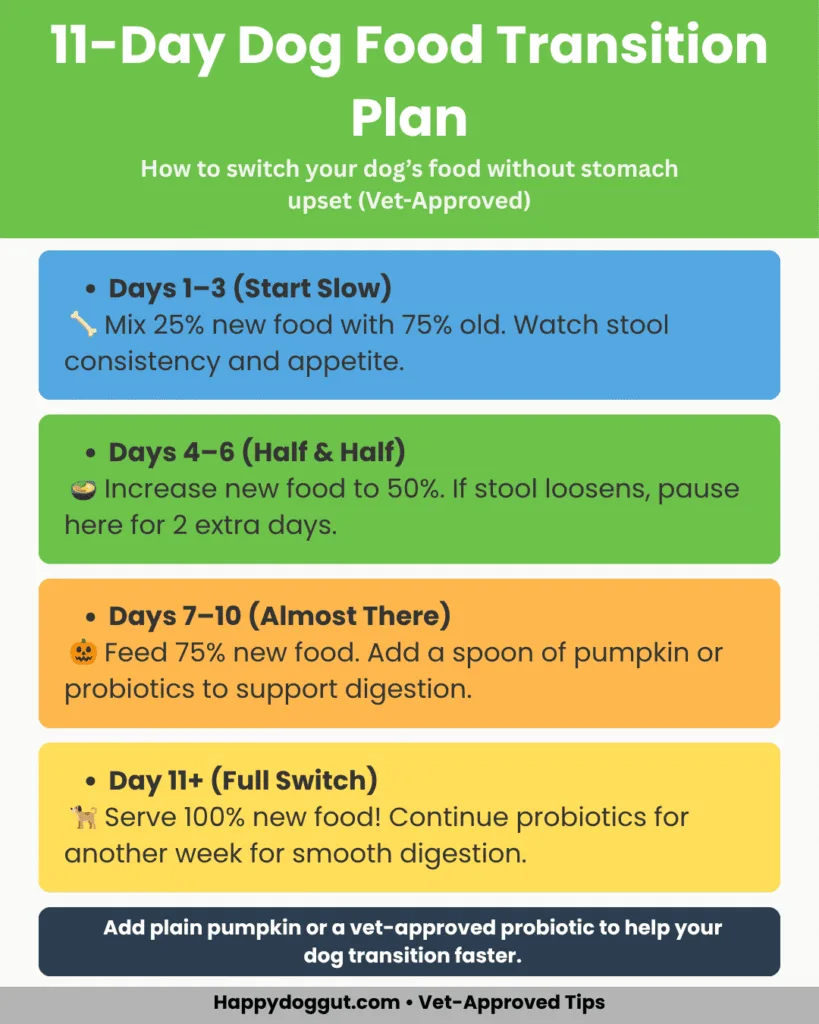
If your dog experiences loose stools during the switch, try our homemade chicken and rice for dogs with diarrhea for a few days before resuming the new food.
Signs Your Dog Isn’t Adjusting Well
Some dogs take longer to adapt. Keep an eye out for warning signs during the transition:
- Diarrhea lasting over 48 hours
- Vomiting or excessive gas
- Refusing food for more than a day
- Lethargy or dehydration
If you notice these, pause the transition and go back one step (e.g., from 50/50 to 75/25 old-to-new ratio).
If symptoms persist, consult your veterinarian — especially for puppies or senior dogs.
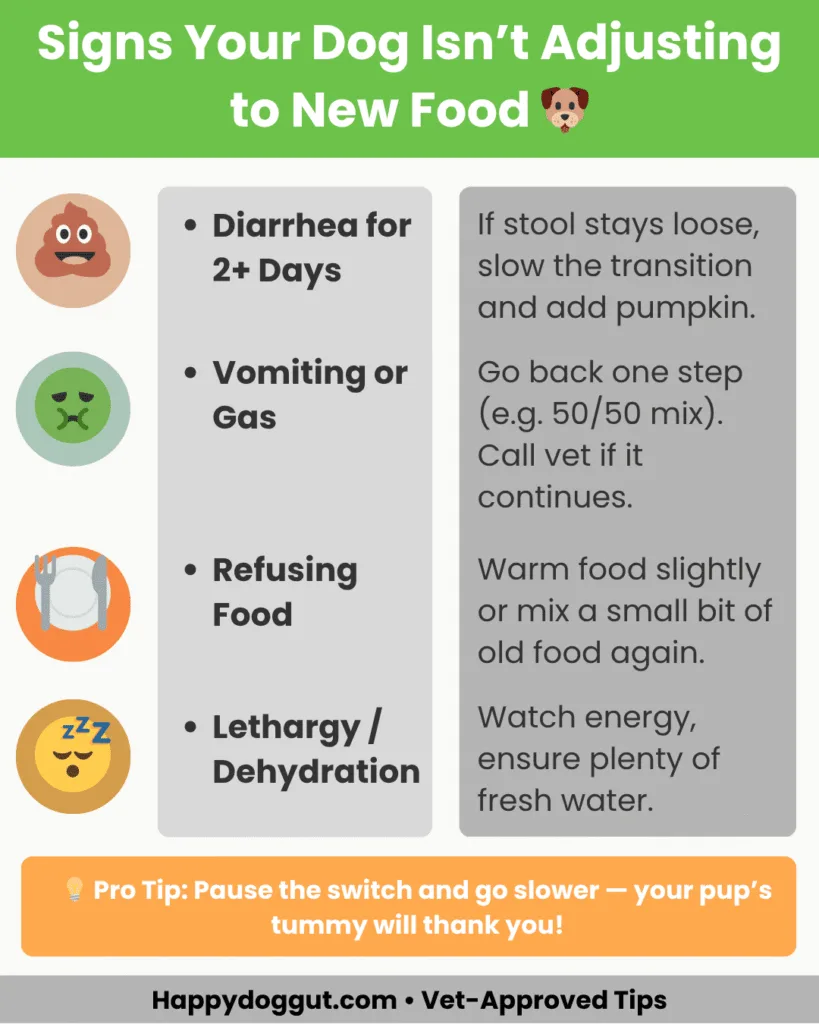
Best Practices for a Smooth Dog Food Transition
To switch dog food without stomach upset and help your pup enjoy the new diet, follow these simple yet effective steps:
🥣 Stick to consistent feeding times.
Dogs thrive on routine. Feeding at the same times each day helps regulate digestion and reduces stress during the transition.
💧 Keep your dog hydrated.
Fresh, clean water supports digestion and prevents dehydration — especially if your dog experiences mild loose stools during the switch.
🦠 Add probiotics for gut health.
Probiotics support healthy gut bacteria and improve nutrient absorption. (AKC on probiotics)
🎃 Include pumpkin or slippery elm.
These natural fibers soothe the stomach, promote regular bowel movements, and reduce inflammation or gas build-up.
🚫 Avoid treats or table scraps.
Introducing extra foods can confuse your dog’s digestive system. Keep the diet simple and focused on the new food during the transition period.
🐕 Encourage regular exercise.
Movement supports healthy digestion and keeps your dog’s metabolism balanced as their system adapts to the new diet.
By following these gentle, consistent steps, your dog’s digestive system will naturally adjust — making the switch smooth, comfortable, and free from stomach troubles. 🌿
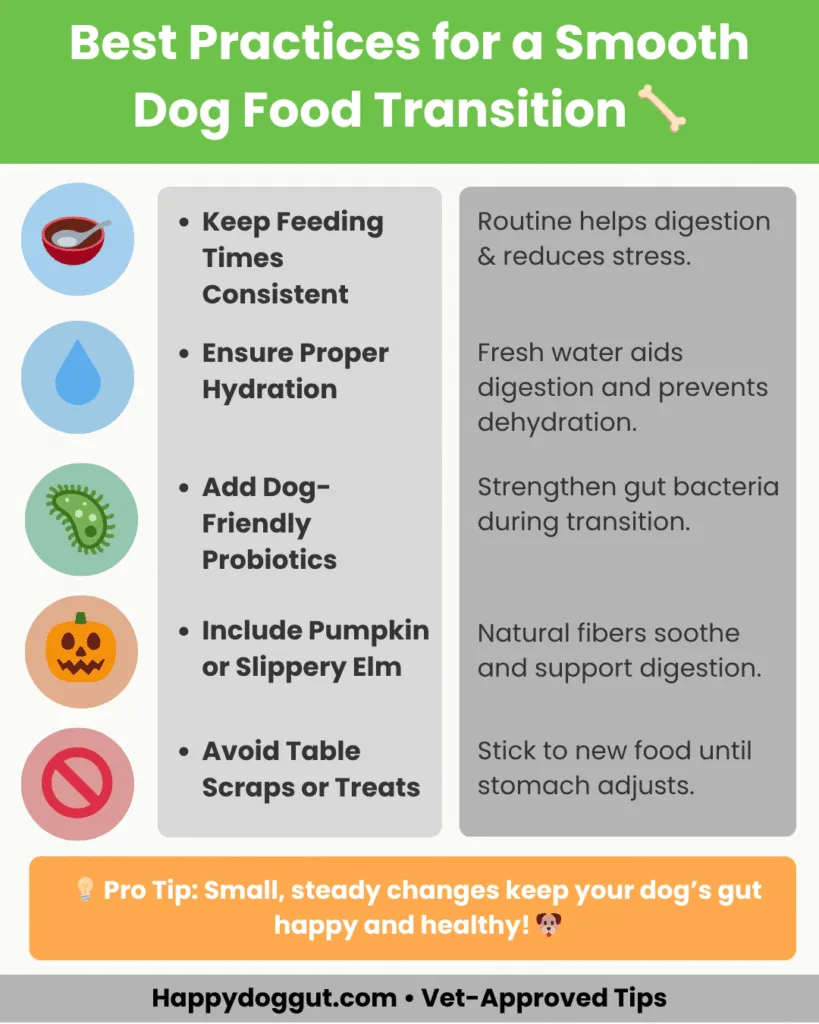
Special Considerations
🐶 Puppies
Puppies have very delicate digestive systems, and even small changes in their diet can cause tummy troubles. When switching dog food for a puppy, do so gradually — ideally over 10 to 14 days.
Start by mixing just a spoonful of the new food with their old food and increase gradually. Always use puppy-formulated food rich in high-quality protein, calcium, and DHA to support growth and brain development.
For puppies, choosing the right formula is crucial. Read our full guide on Best Puppy Food for Sensitive Stomachs to make sure your little one’s digestive system stays strong.
A sudden change can lead to vomiting, diarrhea, dehydration, or even nutritional imbalance. For the best results, introduce the new food during calm periods — not when your pup is stressed or recently vaccinated — to help them adjust without stomach upset.

🐕 Senior Dogs
Older or Senior dogs often have a slower metabolism and reduced digestive enzyme activity, which makes food transitions a little tricky. When you switch dog food for a senior dog, extend the transition to 10 days or more and choose formulas designed for easy digestion.
Look for senior diets that contain natural probiotics, omega-3 fatty acids, and joint-supporting nutrients such as glucosamine and chondroitin. These ingredients help support both gut health and mobility.
Avoid foods high in fat or fillers, as they can cause gas, bloating, and stomach upset. A gradual switch keeps your senior dog’s digestive system stable and comfortable.
Senior dogs may also benefit from added digestive support — see our post on Best Probiotics for Dogs with Sensitive Stomachs for healthy aging tips.

🐩 Dogs with Sensitive Stomachs
If your dog already has a sensitive stomach, a careful, step-by-step transition is crucial. To switch dog food without stomach upset, start with smaller, more frequent meals and monitor stool consistency closely.
Add a spoonful of plain canned pumpkin or veterinarian-approved probiotics to promote healthy gut bacteria and smoother digestion.
Avoid changing both the brand and protein source at the same time — for example, don’t go from chicken to beef plus a new brand all at once.
Keeping one element consistent reduces the risk of diarrhea, nausea, or food refusal. Over time, these gentle changes help your dog’s digestive system adjust naturally to the new food.
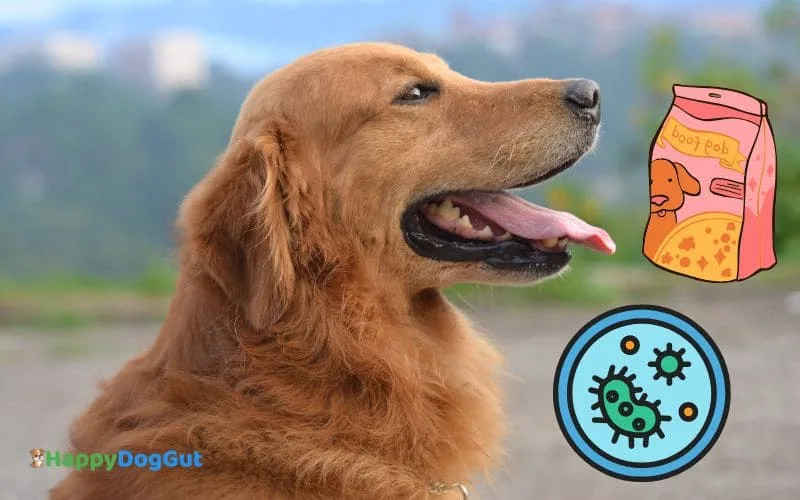
Vet-Recommended Supplements During Food Transition
When you switch dog food without stomach upset, adding the right vet-approved supplements can make a big difference. These natural digestive supports help your dog’s gut adjust smoothly and prevent common issues like loose stools, nausea, or loss of appetite during a diet change.
✅ Probiotics – Probiotics help balance healthy gut bacteria and reduce the risk of diarrhea or gas while transitioning to new food. They strengthen the digestive system and support long-term gut health.
✅ Digestive Enzymes – These help your dog break down proteins, fats, and carbs more efficiently, improving nutrient absorption during the switch. They’re especially helpful for senior dogs or those with sensitive digestion.
✅ Plain Pumpkin (Canned or Fresh) – A natural source of soluble fiber, pumpkin helps firm loose stools and adds gentle bulk for smoother digestion. It’s one of the best natural remedies for sensitive stomachs.
✅ Slippery Elm Bark – A soothing herbal supplement that coats the stomach and intestinal lining, reducing irritation and promoting healing. It’s safe for mild nausea, acid reflux, and minor gut inflammation.
You can find these ingredients in vet-approved supplement brands such as Purina FortiFlora, Zesty Paws Probiotic Bites, or Nutramax Proviable—all trusted for maintaining digestive balance during food transitions.
👉 Always consult your veterinarian before introducing any supplement, especially if your dog has ongoing stomach issues or is on prescription food.
Still deciding between different diet types? Explore our comparison of Grain-Free vs Grain-Inclusive Dog Food for Sensitive Stomachs to understand which formula works best for your dog’s digestion.
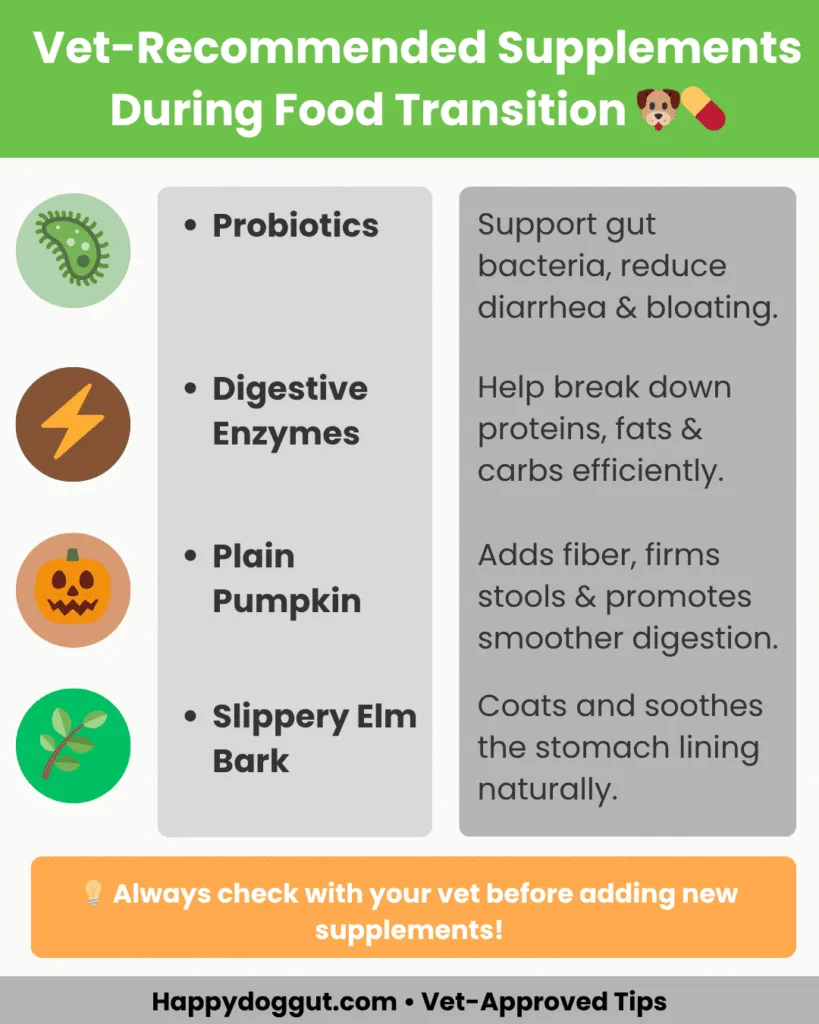
Common Mistakes to Avoid
Even the most loving pet parents can make small mistakes that lead to big tummy troubles. To successfully switch dog food without stomach upset, avoid these common pitfalls:
🚫 Switching foods too quickly
One of the biggest mistakes is rushing the process. A sudden change can shock your dog’s digestive system, causing diarrhea, vomiting, or refusal to eat. Always follow a gradual 9–11 day transition schedule for best results.
🚫 Mixing multiple new foods at once
Introducing a new protein source and new treats or supplements together can confuse your dog’s gut. Stick to one food change at a time, and monitor your pup’s response closely.
🚫 Overfeeding during transition
Too much food—even if it’s healthy—puts stress on your dog’s digestive tract. Feed smaller, more frequent meals instead to help your pup adjust comfortably.
🚫 Ignoring early signs of digestive upset
If you notice gas, soft stools, or loss of appetite, slow down the transition. Catching these signs early can prevent more serious stomach issues later.
🚫 Poor food storage habits
Leaving kibble open or in humid conditions causes it to go stale or moldy, leading to gastrointestinal problems. Store dog food in an airtight container and in a cool, dry place.
👉 Remember: Slow and steady always wins the digestion race. A careful, patient approach keeps your dog’s gut healthy and makes the food switch smooth and stress-free. 🐶💩
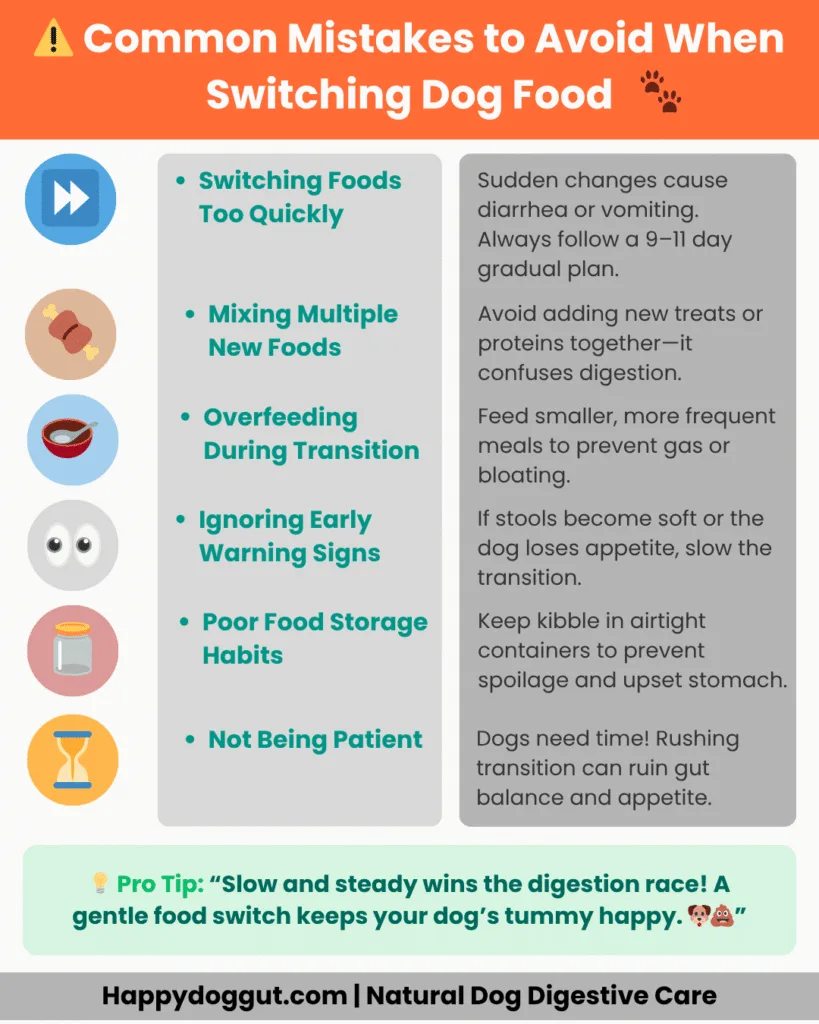
If you prefer natural feeding methods, you’ll love our guide to Homemade Dog Food for Sensitive Stomachs. It includes balanced recipes that are gentle on digestion and vet-approved for everyday nutrition.
FAQs About Switching Dog Food
Q1. How long should a dog food transition take?
A proper dog food transition usually takes 7 to 10 days, allowing your dog’s digestive system to adjust slowly to the new ingredients. However, if your dog has a sensitive stomach or a history of digestive issues, extending the transition to 10–14 days works better.
This gradual process prevents vomiting, diarrhea, and gas by helping your dog’s gut bacteria adapt naturally to the new diet.
Q2. What if my dog refuses the new food?
If your dog turns away from the new food, don’t panic — it’s common! Try warming the food slightly or mixing it with a small amount of low-sodium chicken broth to enhance flavor and aroma. You can also blend in a tiny portion of old food for familiarity. Avoid switching protein sources too drastically (for example, chicken to fish overnight) since sudden flavor changes can upset digestion and appetite.
Q3. Can I mix wet and dry food during the transition?
Absolutely! Combining wet and dry dog food is one of the easiest ways to make the transition smoother. Wet food boosts palatability and hydration, while dry kibble supports dental health.
Just ensure you’re maintaining the same total daily calorie intake — otherwise, your dog might gain weight during the transition period.
Q4. My dog got diarrhea after switching food — what should I do?
If your dog experiences diarrhea or loose stool, it’s a sign the transition is happening too fast. Go back one step — feed more of the old food and less of the new for a few days. Add plain canned pumpkin (rich in soluble fiber) or a probiotic supplement like Purina FortiFlora to restore gut balance.
If diarrhea continues for more than 48 hours, consult your vet to rule out infections or food intolerance.
Q5. Should I use probiotics when changing food?
Yes, probiotics are highly recommended during any food switch. They support healthy gut bacteria, strengthen digestion, and reduce the chances of stomach upset or flatulence.
Adding a high-quality probiotic supplement such as Zesty Paws Probiotic Bites can make the transition easier and improve nutrient absorption from the new food.
Q6. How do I know if the new food suits my dog?
Watch your dog closely during and after the transition. A healthy stool consistency, steady appetite, bright eyes, and good energy levels are all signs that the new food suits your dog.
If you notice excessive itching, bloating, lethargy, or vomiting, it could indicate a food allergy or intolerance — in that case, talk to your veterinarian for guidance.
Q7. Can I switch from puppy to adult food using this method?
Yes — this gradual food transition method works perfectly when moving from puppy to adult food. Follow the 9–11 day blending schedule, slowly increasing the adult food portion each day.
Make sure the adult formula meets your dog’s nutritional needs, especially for large breeds or active dogs, to prevent stomach upset and maintain healthy growth.
Q8. When should I consult a vet during a food transition?
Contact your vet if your dog shows signs like persistent vomiting, diarrhea lasting more than 48 hours, loss of appetite, or extreme lethargy. These symptoms may point to an underlying digestive issue or allergy unrelated to the food switch.
A vet can recommend diagnostic tests or prescription diets that suit your dog’s sensitive stomach.
Final Thoughts
Switching your dog’s food doesn’t have to mean stomach trouble.
With the right transition schedule, a bit of patience, and digestive support, your furry friend can enjoy new flavors — without the tummy drama.

Looking for a natural way to soothe digestion during a food switch? Don’t miss our post on Pumpkin for Dogs’ Sensitive Stomach. Pumpkin adds fiber, firms up stool, and helps your dog adjust smoothly to new food.
For ongoing gut health, don’t miss our guide on How to Calm a Dog’s Upset Stomach Naturally.
🐕 Happy gut = happy dog!
Hi, I’m Maddy, the writer behind HappyDogGut.com.
I’m passionate about helping dog parents understand gut health, sensitive stomachs, and natural nutrition for dogs.
Every article I create is vet-approved, research-backed, and experience-driven, so your pup can enjoy a healthier, happier gut.
Happy gut = happy dog!
All content on Happy Dog Gut follows our Editorial Policy.

